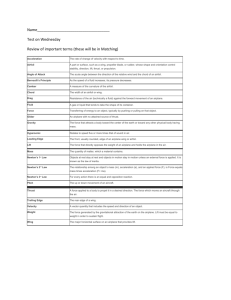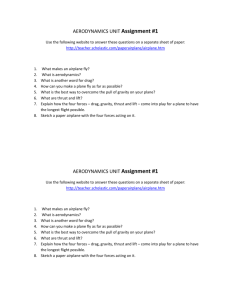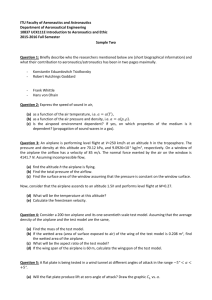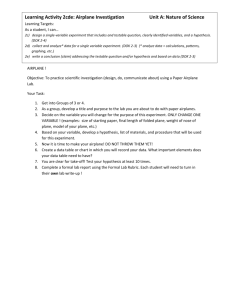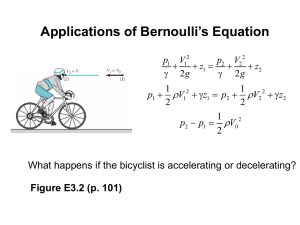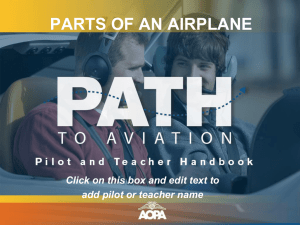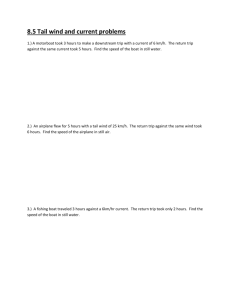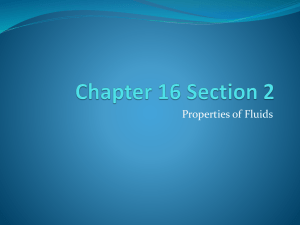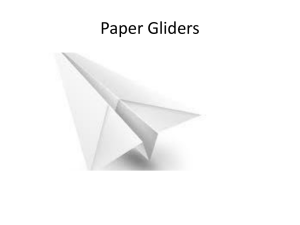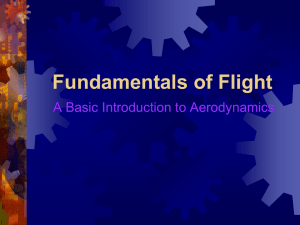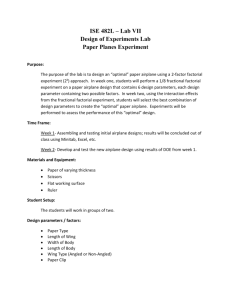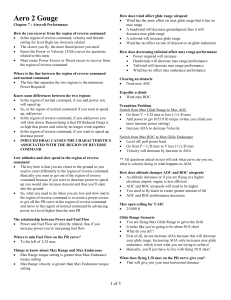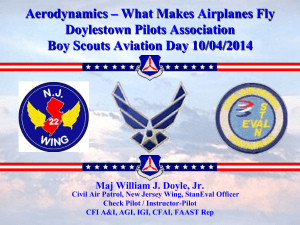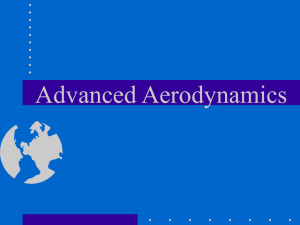Chapter7Chapter8Review
advertisement
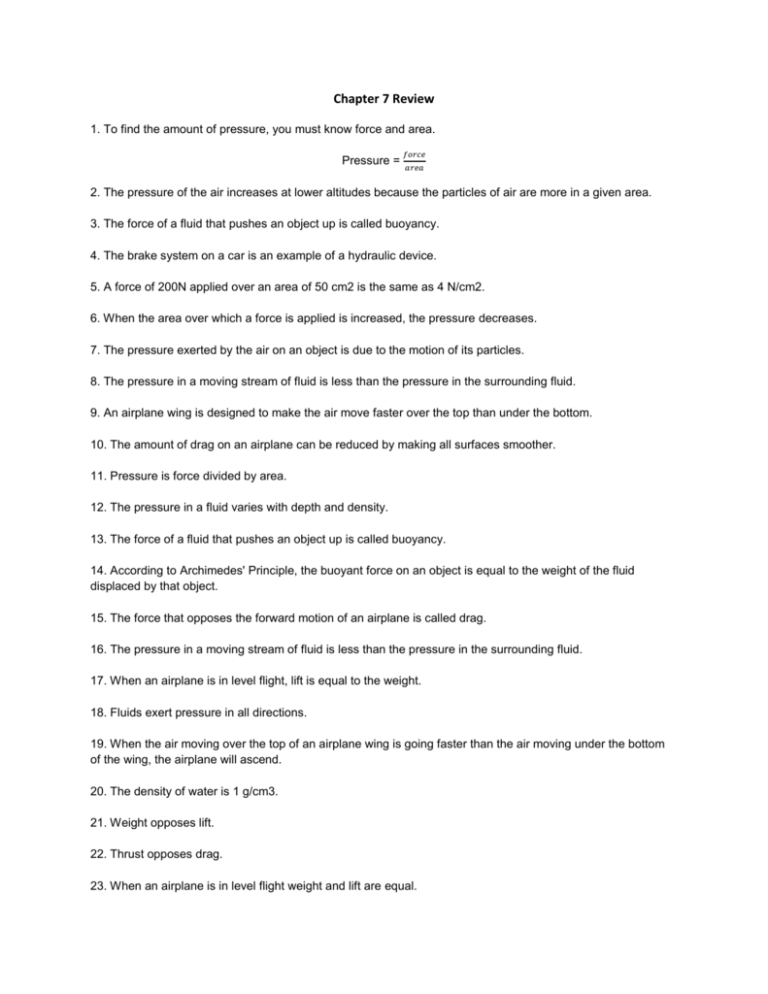
Chapter 7 Review 1. To find the amount of pressure, you must know force and area. Pressure = 𝑓𝑜𝑟𝑐𝑒 𝑎𝑟𝑒𝑎 2. The pressure of the air increases at lower altitudes because the particles of air are more in a given area. 3. The force of a fluid that pushes an object up is called buoyancy. 4. The brake system on a car is an example of a hydraulic device. 5. A force of 200N applied over an area of 50 cm2 is the same as 4 N/cm2. 6. When the area over which a force is applied is increased, the pressure decreases. 7. The pressure exerted by the air on an object is due to the motion of its particles. 8. The pressure in a moving stream of fluid is less than the pressure in the surrounding fluid. 9. An airplane wing is designed to make the air move faster over the top than under the bottom. 10. The amount of drag on an airplane can be reduced by making all surfaces smoother. 11. Pressure is force divided by area. 12. The pressure in a fluid varies with depth and density. 13. The force of a fluid that pushes an object up is called buoyancy. 14. According to Archimedes' Principle, the buoyant force on an object is equal to the weight of the fluid displaced by that object. 15. The force that opposes the forward motion of an airplane is called drag. 16. The pressure in a moving stream of fluid is less than the pressure in the surrounding fluid. 17. When an airplane is in level flight, lift is equal to the weight. 18. Fluids exert pressure in all directions. 19. When the air moving over the top of an airplane wing is going faster than the air moving under the bottom of the wing, the airplane will ascend. 20. The density of water is 1 g/cm3. 21. Weight opposes lift. 22. Thrust opposes drag. 23. When an airplane is in level flight weight and lift are equal. 24. When drag is less than thrust an airplane accelerates. 25. When weight is greater than lift an airplane descends. 26. Buoyancy is the upward force fluids exert on objects. If an object displaces the same weight of water as the weight of the object, it will float. Even though an object sinks, it displaces some water. The resulting buoyant force opposes gravity, thereby making the object seem to lose weight. 27. As an airplane flies, air strikes the front of the wing and separates. Air traveling over the top has farther to go than the air traveling under the bottom, and so it must go faster. The air moving faster over the top creates less pressure than the air moving under the bottom. Lift occurs because the pressure pushing up is greater than the pressure pushing down. 28. A steel ship is not a solid: it contains a large volume of air. The density of the steel plus the air is less than the density of water. 29. In a hydraulic device, there are two cylinders or pistons. One piston has a large surface area. Since force equals pressure times area, the piston with the larger surface area has more force. The larger the difference between the surface area of the two pistons; the greater the force of the larger piston. 30. At sea level, air exerts a pressure of 10.13 N/cm2. The reason we do not feel the pressure is that the pressure inside our bodies equals the pressure outside our bodies. The air gets thinner and exerts less pressure as the height above the earth’s surface increases. Without a pressurized cabin, we would still be exerting the same amount of pressure from inside our bodies, but there would be no pressure pushing back. 31. Be able to calculate pressure equations using pressure, area and force. Also be able to determine the area of an object using length and width. Chapter 8 Review 1. If a large force is exerted on an object, no work is performed if the object does not move. 2. A unit of power is the watt, the kilowatt, or the horsepower. P= 𝑊 𝑡 3. Machines multiply force. 4. The resistance force divided by the effort force is called mechanical advantage. 5. The efficiency of a machine is always less than 100 percent. 𝑤𝑜𝑟𝑘 𝑜𝑢𝑡𝑝𝑢𝑡 mechanical efficiency = x 100 𝑤𝑜𝑟𝑘 𝑖𝑛𝑝𝑢𝑡 6. The mechanical advantage of an inclined plane is found by dividing the length of the plane by its height. mechanical advantage (MA) = 𝑜𝑢𝑡𝑝𝑢𝑡 𝑓𝑜𝑟𝑐𝑒 𝑖𝑛𝑝𝑢𝑡 𝑓𝑜𝑟𝑐𝑒 7. A wheelbarrow is which type of lever? Second-class 8. A moveable pulley has a mechanical advantage greater than one. 9. The gears in a watch are an example of a wheel and axle. 10. An example of a compound machine would be a school bus. 11. Work equals force times distance. W= Fxd 12. Power is work divided by time. 13. One kilowatt equals 1000 watts. 14. Machines multiply an applied force. 15. Work done by a machine is work output. 16. Friction reduces efficiency. 17. A ramp is an inclined plane. 18. A wedge is an inclined plane that moves. 19. A scissors is a first-class lever. 20. A wheel and axle is a lever that rotates in a circle. 21. A unit of work is the joule (J). Joules are a measure of Newtons x meters (Nxm). 22. Power is the rate of doing work. 23. Machines multiply force. 24. Work output is less than work input. 25. The number of times a machine multiplies effort force is called mechanical advantage. 26. There are six simple machines. 27. A screw is an inclined plane wrapped around a cylinder. 28. The fixed point at which a lever is supported is called a fulcrum. 29. A third-class lever multiplies distance. 30. A combination of simple machines is called a compound machine. 31. If there is no motion, there is no work. 32. Power is work divided by time. 33. Machines either multiply the force or distance or change the direction of the force. 34. A bicycle is a combination of several simple machines. 35. Be able to calculate work, power, mechanical advantage and efficiency.
